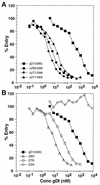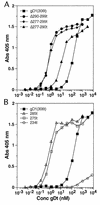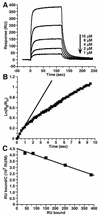Functional region IV of glycoprotein D from herpes simplex virus modulates glycoprotein binding to the herpesvirus entry mediator
- PMID: 9696802
- PMCID: PMC109930
- DOI: 10.1128/JVI.72.9.7091-7098.1998
Functional region IV of glycoprotein D from herpes simplex virus modulates glycoprotein binding to the herpesvirus entry mediator
Abstract
Glycoprotein D (gD) of herpes simplex virus (HSV) is essential for virus entry and has four functional regions (I to IV) important for this process. We previously showed that a truncated form of a functional region IV variant, gD1(Delta290-299t), had an enhanced ability to block virus entry and to bind to the herpesvirus entry mediator (HveAt; formerly HVEMt), a cellular receptor for HSV. To explore this phenotype further, we examined other forms of gD, especially ones with mutations in region IV. Variant proteins with deletions of amino acids between 277 and 300 (region IV), as well as truncated forms lacking C-terminal residues up to amino acid 275 of gD, were able to block HSV entry into Vero cells 1 to 2 logs better than wild-type gD1(306t). In contrast, gD truncated at residue 234 did not block virus entry into Vero cells. Using optical biosensor technology, we recently showed that gD1(Delta290-299t) had a 100-fold-higher affinity for HveAt than gD1(306t) (3.3 x 10(-8) M versus 3.2 x 10(-6) M). Here we found that the affinities of other region IV variants for HveAt were similar to that of gD1(Delta290-299t). Thus, the affinity data follow the same hierarchy as the blocking data. In each case, the higher affinity was due primarily to a faster kon rather than to a slower koff. Therefore, once the gDt-HveAt complex formed, its stability was unaffected by mutations in or near region IV. gD truncated at residue 234 bound to HveAt with a lower affinity (2.0 x 10(-5) M) than did gD1(306t) due to a more rapid koff. These data suggest that residues between 234 and 275 are important for maintaining stability of the gDt-HveAt complex and that functional region IV is important for modulating the binding of gD to HveA. The binding properties of any gD1(234t)-receptor complex could account for the inability of this form of gDt to block HSV infection.
Figures






Similar articles
-
Examination of the kinetics of herpes simplex virus glycoprotein D binding to the herpesvirus entry mediator, using surface plasmon resonance.J Virol. 1998 Jul;72(7):5937-47. doi: 10.1128/JVI.72.7.5937-5947.1998. J Virol. 1998. PMID: 9621056 Free PMC article.
-
The major neutralizing antigenic site on herpes simplex virus glycoprotein D overlaps a receptor-binding domain.J Virol. 1999 Dec;73(12):9879-90. doi: 10.1128/JVI.73.12.9879-9890.1999. J Virol. 1999. PMID: 10559300 Free PMC article.
-
Glycoprotein D of herpes simplex virus (HSV) binds directly to HVEM, a member of the tumor necrosis factor receptor superfamily and a mediator of HSV entry.J Virol. 1997 Aug;71(8):6083-93. doi: 10.1128/JVI.71.8.6083-6093.1997. J Virol. 1997. PMID: 9223502 Free PMC article.
-
Monoclonal antibodies to distinct sites on herpes simplex virus (HSV) glycoprotein D block HSV binding to HVEM.J Virol. 1998 May;72(5):3595-601. doi: 10.1128/JVI.72.5.3595-3601.1998. J Virol. 1998. PMID: 9557640 Free PMC article.
-
Herpes simplex virus glycoprotein D can bind to poliovirus receptor-related protein 1 or herpesvirus entry mediator, two structurally unrelated mediators of virus entry.J Virol. 1998 Sep;72(9):7064-74. doi: 10.1128/JVI.72.9.7064-7074.1998. J Virol. 1998. PMID: 9696799 Free PMC article.
Cited by
-
Aptamer that binds to the gD protein of herpes simplex virus 1 and efficiently inhibits viral entry.J Virol. 2012 Jun;86(12):6732-44. doi: 10.1128/JVI.00377-12. Epub 2012 Apr 18. J Virol. 2012. PMID: 22514343 Free PMC article.
-
Molecular determinants of the interaction between HSV-1 glycoprotein D and heparan sulfate.Front Mol Biosci. 2022 Nov 7;9:1043713. doi: 10.3389/fmolb.2022.1043713. eCollection 2022. Front Mol Biosci. 2022. PMID: 36419932 Free PMC article.
-
Engineered disulfide bonds in herpes simplex virus type 1 gD separate receptor binding from fusion initiation and viral entry.J Virol. 2008 Jan;82(2):700-9. doi: 10.1128/JVI.02192-07. Epub 2007 Nov 21. J Virol. 2008. PMID: 18032483 Free PMC article.
-
The membrane-proximal region (MPR) of herpes simplex virus gB regulates association of the fusion loops with lipid membranes.mBio. 2012 Nov 20;3(6):e00429-12. doi: 10.1128/mBio.00429-12. mBio. 2012. PMID: 23170000 Free PMC article.
-
Surface Plasmon Resonance Reveals Direct Binding of Herpes Simplex Virus Glycoproteins gH/gL to gD and Locates a gH/gL Binding Site on gD.J Virol. 2019 Jul 17;93(15):e00289-19. doi: 10.1128/JVI.00289-19. Print 2019 Aug 1. J Virol. 2019. PMID: 31092568 Free PMC article.
References
-
- Biacore AB. BIAevaluation software handbook, version 3.0. Uppsala, Sweden: Biacore AB; 1997.
Publication types
MeSH terms
Substances
Grants and funding
LinkOut - more resources
Full Text Sources
Other Literature Sources
Research Materials

